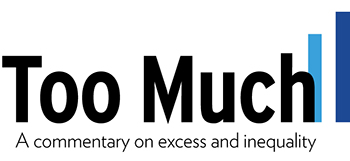The Trump White House is framing foreign aid as a devastating drain on America’s treasure. But foreign aid isn’t killing the American dream. Inequality is.
By Sam Pizzigati
Americans on average, pollsters report, believe that over a quarter of the federal budget — 26 percent — goes for foreign aid. But outlays for foreign aid, the actual budget numbers show, make up just 1 percent of what the federal government annually expends.
Don’t expect this startling gap between perception and reality to narrow anytime soon. We now have in the White House a President who’s exaggerating — at every opportunity — what the United States spends on foreign assistance.

The World Health Organization now sees Somalia at risk for its third famine in 25 years. [UNICEF]
The United States, Trump continued, has “spent trillions and trillions of dollars overseas, while our infrastructure at home has so badly crumbled.”
Real life has a different story to tell. Over recent years, U.S. tax dollars have been about as likely to bomb bridges in other lands as build them. A huge share of our tax dollars that flow overseas go for armaments, ammunition, and other forms of military assistance.
In the current federal fiscal year, for instance, we’re spending $3.67 billion outfitting the security forces in Afghanistan, but only $3 billion worldwide on development assistance.
Overall, we are spending $25.6 billion trying to help people in other nations on non-military levels, adding up outlays for everything from global health programs to the Peace Corps. That total certainly seems substantial. But this particular story has another side: Among the world’s wealthy nations, no nation spends as little on building up people and infrastructure abroad as the United States.
United Nations resolutions currently ask developed countries to contribute 0.7 percent of their gross national income toward foreign assistance. The United States contributes just 0.17 percent, less than a quarter of the recommended giving level. Developed nations, on average, contribute almost twice as large a share of their national incomes as the United States.
Some nations exceed the UN recommendation. Sweden, for instance, contributes double what the UN recommends, a share of national income over eight times as large as the United States contributes.
More unequal nations spend less helping people in need.
The nations that exceed the UN guidelines on foreign assistance contributions, the British epidemiologists Richard Wilkinson and Kate Pickett point out in their landmark 2009 book The Spirit Level, all share a common characteristic. They have much more equal internal distributions of income than nations that contribute little.
“More unequal countries,” Wilkinson and Pickett note, “spend significantly lower percentages of their income on foreign aid.”
More unequal nations turn out to share their own sets of characteristics. Unequal societies spend less on public services. They have higher levels of crime and lower levels of trust. People in more unequal nations live shorter lives, struggle with more personal debt, and face more mental health problems.
People who live amid high levels of inequality, in short, have plenty of reasons to feel stressed and frustrated. They also tend to have plenty of politicians hovering around eager to exploit that frustration — and distract attention from the rich and powerful and the inequality their grand private fortunes engender.
“Foreign aid” has always been an easy target for these exploiters. But foreign aid has never been the problem. The problem has been — and remains — a distribution of income and wealth that privileges the few at the expense of the great many.
Institute for Policy Studies associate fellow Sam Pizzigati co-edits Inequality.org. His most recent book: The Rich Don’t Always Win: The Forgotten Triumph over Plutocracy that Created the American Middle Class, 1900–1970. Follow him on Twitter @Too_Much_Online.



Discussion
No comments for “Has America Become Too Generous?”